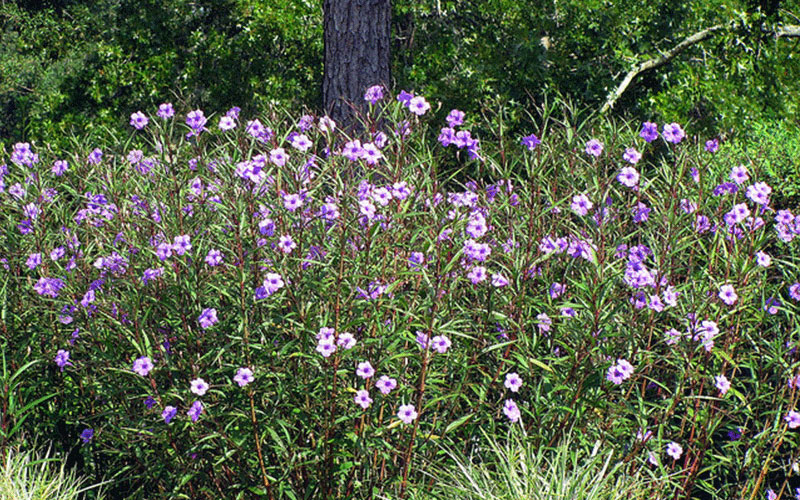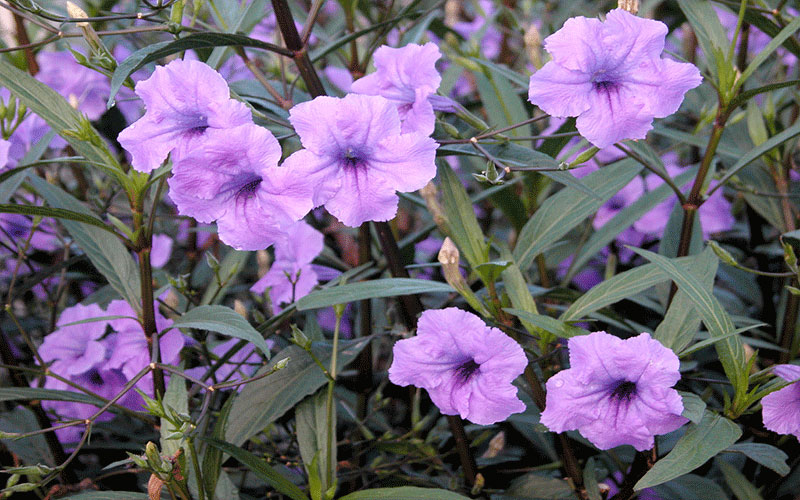Explore The MEXICAN PETUNIA

The leaves have a somewhat grassy look, and flowers cluster around the center of each plant and attract butterflies. Low growing ground covers like this one look great when planted in a bed near the entry, as front-of-the-border plants along the foundation, in a mixed bed or surrounding shrubs.
Learn More About The MEXICAN PETUNIA
Planting Instructions
The Mexican Petunia is very popular as one of South Florida's prettiest purple flowering plants. But some homeowners fear it will get away from them since it re-seeds and spreads.
Plant in spring, summer, or fall, spacing plants 3 to 6 feet apart. Dig a hole only as deep as the root ball and 2 to 3 times as wide. If your soil is in very poor condition, amend the soil you've removed from the hole with a small amount of compost. Otherwise don't amend it at all. Carefully remove the plant from the container and set it in the hole.
Fill the hole half full with soil, then water it well to settle the soil and eliminate air pockets.The dwarf Mexican Petunia is somewhat more tame. Though it also sends seeds out to sprout in surprising places, the ground cover's wayward seedlings can be mowed over in the lawn, removed from garden beds and sprayed with a herbicide when they spring up from cracks in the sidewalk.
Plant in spring, summer, or fall, spacing plants 3 to 6 feet apart. Dig a hole only as deep as the root ball and 2 to 3 times as wide. If your soil is in very poor condition, amend the soil you've removed from the hole with a small amount of compost. Otherwise don't amend it at all. Carefully remove the plant from the container and set it in the hole.
Fill the hole half full with soil, then water it well to settle the soil and eliminate air pockets.The dwarf Mexican Petunia is somewhat more tame. Though it also sends seeds out to sprout in surprising places, the ground cover's wayward seedlings can be mowed over in the lawn, removed from garden beds and sprayed with a herbicide when they spring up from cracks in the sidewalk.
Plant Care Tips
Dwarf Mexican petunia will grow in full sun to partial shade (though you'll get the most flowers in more sun). These plants are cold hardy. In Zone 9B they may die back in winter but usually bounce back in spring.
Even in Zone 10, some leaves may turn a reddish color during winter's cold snaps. Dwarf Mexican petunia is salt tolerant and grows to about 10 inches tall. Spent flowers turn to a tan mush that can dry on the foliage and take a while to disappear.
Even in Zone 10, some leaves may turn a reddish color during winter's cold snaps. Dwarf Mexican petunia is salt tolerant and grows to about 10 inches tall. Spent flowers turn to a tan mush that can dry on the foliage and take a while to disappear.




